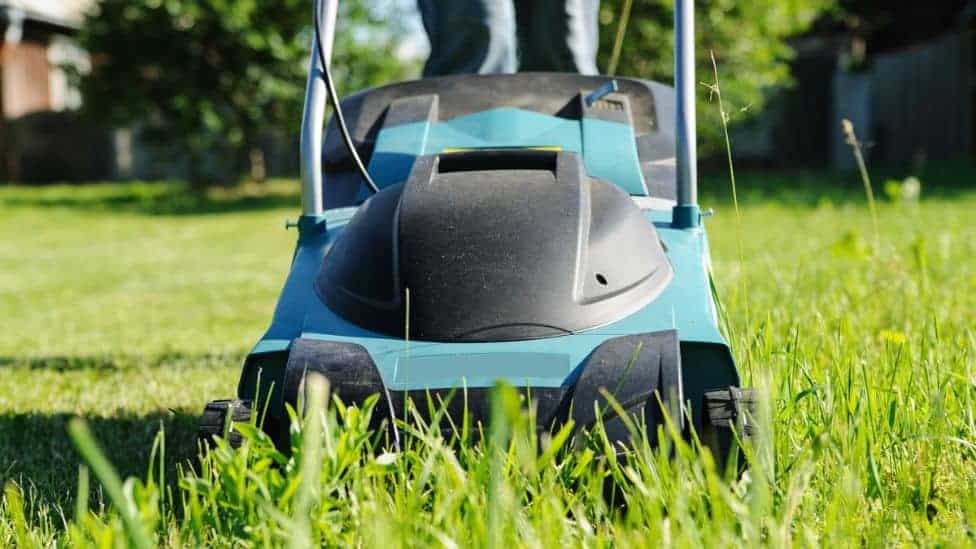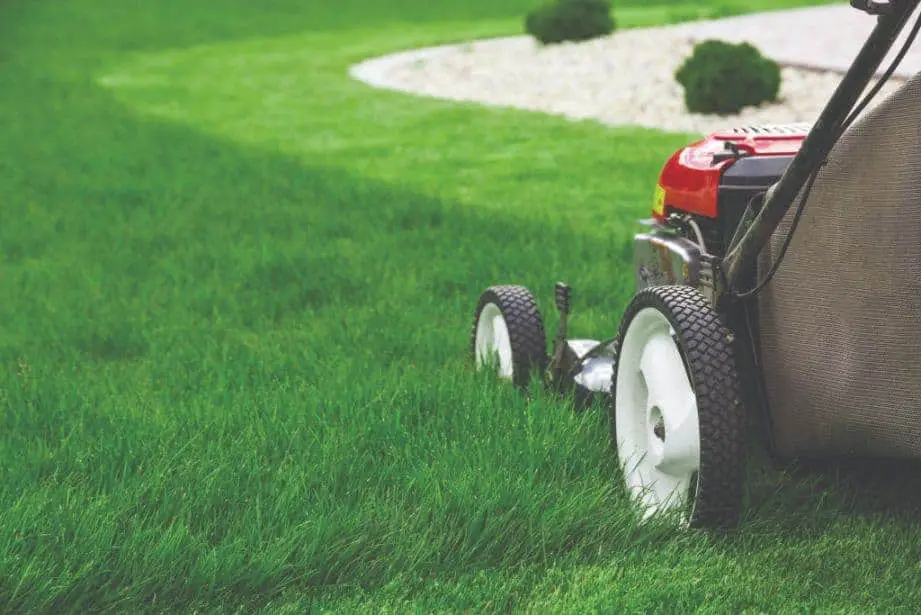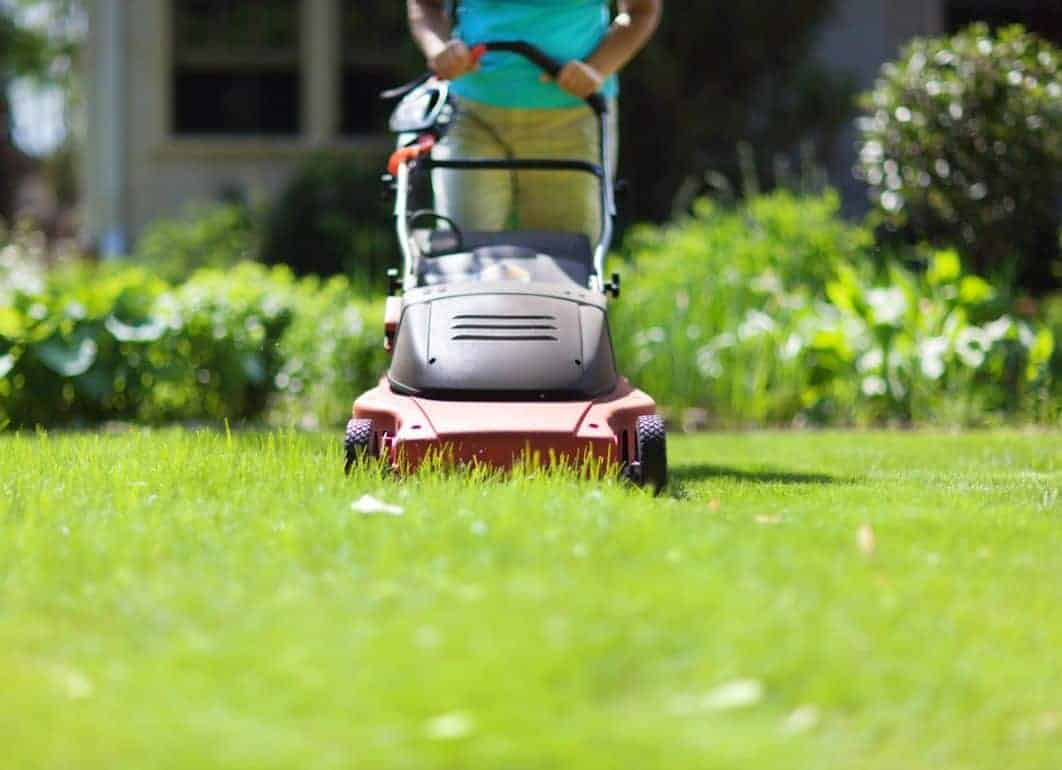This is a point of contention for many gardeners the world over. It can be so tempting to quickly zoom your mower around your lawn after a bit of rainfall or after your sprinklers have done their thing, but before you do so, keep reading!
A lawn mower is an expensive bit of gardening kit, so the last thing you want to do is damage yours. Knowing the best conditions for mowing and the conditions to avoid can help to ensure your lawn mower is kept in tip-top shape for as long as possible!

So, what’s the answer then? Can you use your electric mower on wet grass?
Most experts would say definitely not, and they would be absolutely correct! Using any kind of lawn mower on wet grass could spell catastrophe for both the mower and the user, but electric mowers in particular are not a good pairing with a soggy lawn.
Although it can be tempting to mow your lawn when it’s looking shiny and luscious from being damp, this will only cause you more problems and if you keep reading, you’ll find out exactly why. The issues you’ll face fall into three main categories which we’ll explore: dangers to you, dangers to your lawn mower, and dangers to your grass.
It’s easy to forget that we become a part of the mowing ecosystem when we cut our grass. I mean after all, the mower does all the real work, we only have to push it along. But let’s be honest for a second here:

You are far more important than your lawn mower (no matter how expensive the model is) and you’re definitely more important than your grass.
So, it makes sense that as much as we want to make our lawn look nice and tidy and manicured, and as much as we want to keep our lawn mower in good condition, we should also want to make sure we are safe while we mow our lawns.
And therein lies the problem with using a lawn mower on wet grass. From an early age, we are taught that water and electricity don’t mix. That’s why we don’t use our hairdryers while we’re in the bath or go swimming during electrical storms.
Using an electric lawn mower on wet grass can lead to a risk of electric shocks, particularly if your lawn mower is a bit older or has loose connections or other component damage. Getting shocked is not a pleasant experience even if it’s mild and ultimately harmless so it’s best to avoid wet grass when mowing.
When pushing a lawn mower, you exert some force on the machine and tend to lean forwards a little bit, even if you aren’t pushing hard or fast. Leaning forward even slightly whilst standing on wet grass can result in your foot slipping and you falling over.
In the best-case scenario, you just fall over and get back up with some damp patches on your hands and knees. In the worst-case scenario, you fall forwards and smack your face on your lawn mower or catch your hair or fingers in the blades – safe to say no one wants that!
Electric lawn mowers are generally very efficient and reliable machines that can last for many years with regular use. Introduce water into the mix however, and you’ve got a recipe for disaster. For the same reason that you wouldn’t leave your lawn mower out in the rain, you shouldn’t use it on wet grass – water can cause all kinds of issues!

Any exposed connections that get wet could cause an electrical short, or other issues that could mean long-term damage, and as we all know, moisture causes rust in some metals. There’s a high likelihood that your electric lawn mower has some rust-susceptible components that will be damaged if water droplets or damp grass clippings get caught in them.
Clumps of wet grass also pose another danger in that they become more difficult to remove as time goes on and can cause blockages if not dealt with immediately. Anything that hinders the rotation of your mower’s blades or the movement of other parts will cause additional resistance that will result in damage to the machine.
Motor strain is another danger, as wet grass is typically much harder to mow than dry grass, especially if it’s a bit on the long and unruly side. If your electric lawn mower motor has to work too hard for too long, it could stop working altogether.
Wet grass is also more likely to stain your mower than dry grass, and although cosmetic issues aren’t that big of a deal and won’t affect the operation of your mower, they’re still worth considering.
The whole point of mowing your lawn is to keep it in good condition and looking healthy and tidy. Mowing your lawn when it’s wet can completely negate this point and actually ruin the aesthetics and health of your grass.

Wet grass, particularly if it’s long enough to need mowing, will likely be slightly bent over or hanging due to the extra weight of the water. This means that when you mow over it, you won’t be cutting the same amount off each blade of grass, which could result in an uneven and prickly lawn once it dries.
Wet grass tends to clump together too, which will mean increased resistance for your lawn mower blades. If your blades aren’t perfectly sharp, you also run the risk of them not being able to slice through wet grass clumps at all, knocking them over instead. Once these clumps dry and spring up again, you’ll be able to notice all the patches you missed.
If your lawn is wet, it’s probably also a bit muddy and as we all know, mud is not the most stable of surfaces. Mowing on muddy terrain can leave wheel ruts in your lawn, rip up grass instead of cutting it, and cause you to trim too much or too little if the muddiness has created depressions in the lawn.
All of these issues will not only make your lawn look uneven and patchy, but will also affect the integrity of the soil and health of your grass.
As you can probably tell by now, the best conditions to break out your electric lawn mower will be when it’s dry outside and the ground is also dry. In peak mowing season, dry days shouldn’t be too hard to come by and the temperature should be nice and warm too, helping to dry out any residual moisture.

Mowing in midday sun can be quite strenuous so to avoid risking things like sunburn, heat stroke, dehydration, and exhaustion, it’s best to mow your lawn earlier in the morning or in the afternoon when the sun is not at its harshest.
If you have any newly seeded areas in your lawn or have been trying to fill out any bald patches, you should avoid mowing over these bits until the new grass is at least 4cm tall. Mowing over young grass seedlings will be too harsh on their tender stems and could kill them, putting you back at square one.
If you’re going to be using the mulching attachment on your electric mower then it’s also important to do so on dry grass. Trying to mulch wet grass clippings will only result in a sludgy, clumpy mess that is difficult to spread evenly across your lawn and more difficult for microorganisms in the soil to break down.
Cutting your grass is not a life-or-death situation and it will be extremely unlikely that there’s an important deadline you have to meet. The best advice therefore is just to wait until your lawn has dried completely before you attempt to mow it.

Not only will you be ensuring you keep yourself safe, you’ll also be preserving your electric lawn mower and your grass – everyone wins!
It’s important to mention that any shaded areas of your garden will take a bit longer to dry as the evaporation of moisture will be slower in the cooler, darker conditions. Testing shaded areas for dampness is probably the best way to see if your lawn should be mowed as it will give you a more representative measurement.
There are some lawn mower models that have been specifically designed to be able to mow in wet conditions so if for some reason you feel this is necessary, it’s definitely worth researching a waterproof model.
Short of having a waterproof mower, no mower wants to be used on wet grass, especially your electric mower!